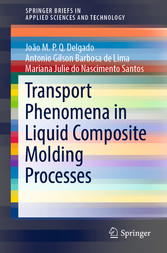Suchen und Finden
Service

Transport Phenomena in Liquid Composite Molding Processes
João M.P.Q. Delgado, Antonio Gilson Barbosa de Lima, Mariana Julie do Nascimento Santos
Verlag Springer-Verlag, 2019
ISBN 9783030127169 , 92 Seiten
Format PDF, OL
Kopierschutz Wasserzeichen
Geräte
Preface
6
Acknowledgements
8
Contents
9
1 Introduction
11
1.1 Motivation
11
1.2 What Is a Composite Material?
12
1.3 Polymer Composite Manufacturing Processes
16
1.3.1 Hand Lay-up Molding
16
1.3.2 Spray-up Molding
17
1.3.3 Vacuum Bag Molding
17
1.3.4 Autoclave Molding
18
1.3.5 Compression Molding
18
1.3.6 Filament Winding
18
1.3.7 Pultrusion
19
1.3.8 Liquid Molding
19
References
21
2 The Liquid Composite Molding Process: Theory and Applications
24
2.1 Foundations
24
2.2 Advantages and Disadvantages of the RTM Technique
27
2.3 Engineering Applications
29
References
29
3 Advanced Experiments in RTM Processes
31
3.1 The Liquid Molding System
31
3.2 Rectilinear Infiltration
31
3.3 Radial Infiltration
35
References
39
4 RTM Process Modeling
41
4.1 The Physics of the RTM Process
41
4.2 Mathematical Modeling and Numerical Simulations in RTM Processes: An Overview
43
4.3 Fundamental Transport Equations
44
4.3.1 Fluid Flow
44
4.3.2 Heat Transfer
46
4.4 Isothermal One-Dimensional Flow: An Analytical Approach
47
4.4.1 Rectilinear Single-Phase Flow
47
4.4.2 Radial Single-Phase Flow: One-Dimensional Approach
58
References
67
5 RTM Simulations by CFD
70
5.1 General Comments
70
5.2 Isothermal Two- and Three-Dimensional Flows
71
5.2.1 Rectilinear Single-Phase Flow
71
5.2.2 Radial Single- and Two-Phase Flows
75
5.2.3 Two-Dimensional and Two-Phase Flow: A Boundary-Fitted Curvilinear Coordinate’s Application
79
5.2.4 Initial and Boundary Conditions
83
5.2.5 Applications
84
References
88
6 Conclusions
91
Shop


